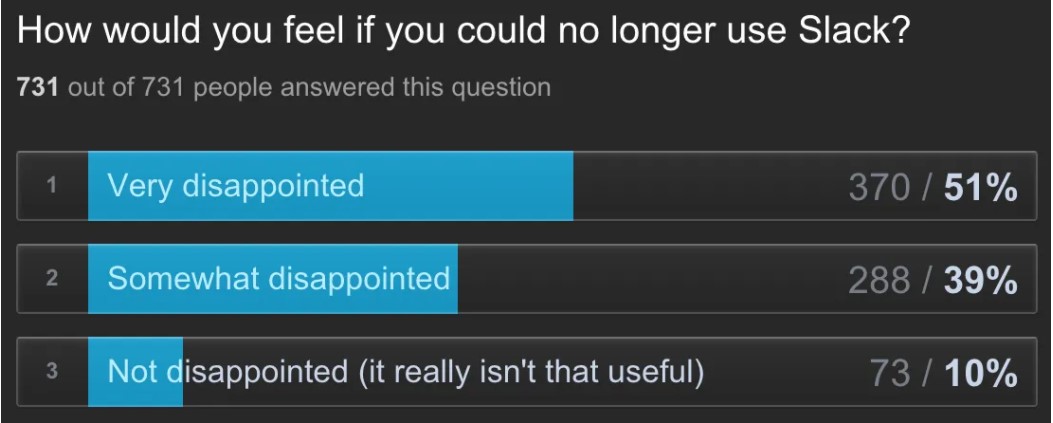Defining Product/Market Fit
As the person in charge of running and scaling a business, you want to ensure your products and services are in demand. Ideally, your company launches products that fulfill a need or solve a problem that troubles your chosen market; therefore, becoming a necessity to your audience.
By definition, product/market fit is the beginning stage of a startup’s journey. That is, it has successfully identified its target customer(s) and served them with the right product – a product that they need and enjoy using.
To get to this point, your business must work to become attractive and satisfy the interest(s), need(s), and desire(s) of your market segment.
Essentially, it means a business has found the right product that can satisfy its market.
Product/market fit is a concept that will help your team inspire a greater variety of ways to create more value for your customers and grow your business.
Before launching a new product, make sure you have reliable answers to the following:
- Who will use it/who it is destined for
- How much/how often it will be used
- How it will be used
- Which pain points it helps solve
- How it will bring in money to your business
You need to ensure you are offering and marketing your products to the right audience.
Your team can ask itself: is there a demand for the product we are offering? Does our target consumer suffer from the specific pain point our product addresses?
Ideally, you want to find the right fit as quickly as you can. This will allow you to focus on growing your business instead of investing time and money in “reinventing” your product to find the perfect product/market fit.
Once you identify the right combination of product and its ideal market, the next logical step is for a business to focus on finding customers within their target audience to start scaling your business.

Introducing the Sean Ellis Test
No product can be successful unless it satisfies a need within a specific market. Regardless of how innovative an idea may be, if it does not cater to one particular group of people, its marketability and earning potential are likely to decrease.
Assessing if your latest product has a promising future can be a daunting task. How can you measure whether your target audience likes it or not? This crucial piece of information is essential – you do not want to invest more time and money on something that is not making the impact you want.
One of the most important metrics you can use to determine if you have found the right product/market fit combination is the Sean Ellis Test.
Named after Sean Ellis, a startup consultant responsible for coining the phrase “growth hacking,” the Sean Ellis Test is one of the most effective and direct ways to obtain qualitative information about your product.
How the Sean Ellis Test works
A survey, this test allows startups and Fortune 500 companies alike to determine how much of a “fit” their product is to the audience currently being targeted with that market.
In your survey, you can ask respondents any questions your team decides will provide enough information and feedback to determine how good of a fit your product is to its current market. However, there is one specific question to include:
How would you feel if you could no longer use our product?
Make sure to include the following multiple-choice answers:
- Very disappointed,
- Somewhat disappointed, or
- Not disappointed.
You do not want to give respondents an open-ended question. They may not know what to answer, or their response may not provide you the insight your team is looking for.
If more than 40% of the respondents answered, they would be “very disappointed” if they could no longer use your product, that means you have found a great product/market fit! This means your target market sees value in the product you offer.
Not every person who has tried your product may be qualified to participate in your Sean Ellis Test. Ideally, you want to apply the survey to candidates who fulfill the following requirements:
- They have experienced the core product or the service,
- They have experienced the product or service at least two times, and
- They have experienced the product or the service in the last two weeks.
Respondents who fulfill these three criteria are more likely to understand how your product or service works and see the higher value it offers.
Slack and the Sean Ellis Test
Back in 2015, Hiten Shah surveyed 731 Slack users who volunteered to take part in this test. In it, he asked some questions that would help the Slack team determine how their customer base started using their product, and if they would recommend it to others. You can check out the survey here.
Once the results were in, the Slack team was able to determine just how much of a fit their product was to their intended audience.
 (Source: Hitenism)
(Source: Hitenism)
As we can see from the image above, 51% of respondents agreed they would be very disappointed if they could no longer use Slack.
This is a good indicator that your business has cemented its place in the market with your product. To make the most of this, make sure to invest your efforts in optimizing your marketing strategies to appeal to the highest number of individuals within your market.
When you do not attain a 40% response
While you can breathe a sigh of relief if your survey respondents determine they would be very disappointed if they could no longer use your product, keep in mind this will not always be the case.
At times, most users will say they would be somewhat disappointed or even not disappointed. While this is not the answer you want, answers like these are perfect indicators of what or how you can upgrade your product to fit a specific market best.
Interpreting your results
When interpreting your results, you want to understand and interpret your respondents’ answers to gain the most significant insight possible, and improve your product, seek a different market, or both.
Let us look at how you can analyze the results from the question:
How would you feel if you could no longer use our product?
The key to making this work is to find common factors from participants’ answers. We can start with the much-anticipated answer, “very disappointed.”
Very Disappointed
Like we mentioned above, if most of your respondents or more than 40% of them respond, they would be “very disappointed” if they could no longer use your product, then you can be sure you have acquired a good product/market fit.
While this does not guarantee long-term success, it does indicate that your product is on the right track to reach and make an impact on the highest number of people.
Somewhat Disappointed
If most of your survey respondents answered, they would be “somewhat disappointed” if they could no longer use your product, then you are very close to reaching an ideal product/market fit.
With an answer like this, as a business, your team should pinpoint the factors that make your consumer base only partially disappointed in losing access to your product.
Invest in determining what sets apart the participants who answered, “very disappointed” to those who decided they would only be “somewhat disappointed.” If possible, you can offer the respondents to participate in another survey to assess what is causing a discrepancy in answers.
Do not forget to ask them what characteristic(s) of your product would likely make them choose the “very disappointed” option. This strategy would require open-ended questions, giving participants the freedom to express their thoughts.
Make sure to use the words and phrases in their answers to improve your business’s overall strategy, improve your product, and enhance your product’s marketing copy.
Not Disappointed
If most of the survey participants answered “not disappointed” if they were not able to use your product or service, then you have a product/market misfit.
If you want to scale your business with that product, then you need to act.
Like you will need to understand why participants would be “somewhat disappointed” if they did not have access to your product, you will also need to know why your consumer base does not find your product attractive.
The best course of action is to offer a follow-up survey to the respondents who answered: “not disappointed.”
Ask questions that give you clear-cut answers to the following points:
- How you can improve your product,
- The product features consumers value the most, and
- The product features consumers like the least.
Once your team can pinpoint how and why your product is not fit for its current market, you can develop and enhance its features, presentation, or the marketing strategy your company is using.
If you want to go a step further, determine if the participants who answered “not disappointed” have some characteristics in common. If they do, they may fall within a specific persona within your target audience. This would also indicate that they have pain points that are slightly different than those from the buyer persona(s) you are currently selling your product to.
Product/Market Fit is crucial for business growth
Product/market fit can make or break your product’s and your business’s success. Every company needs to determine the target market(s) they cater to and develop products that efficiently add value or solve the typical problems of their consumer base.
The Sean Ellis Test is a simple, yet effective method any startup or well-established company can use to obtain raw and honest feedback about a product. To collect quality qualitative data from this test, make sure the questions you ask encourage participants to be specific in their answers.




